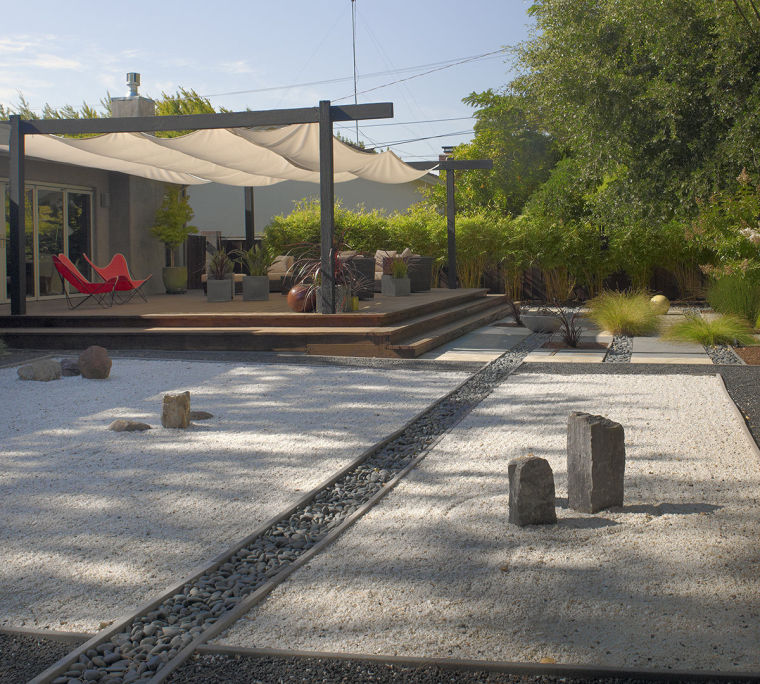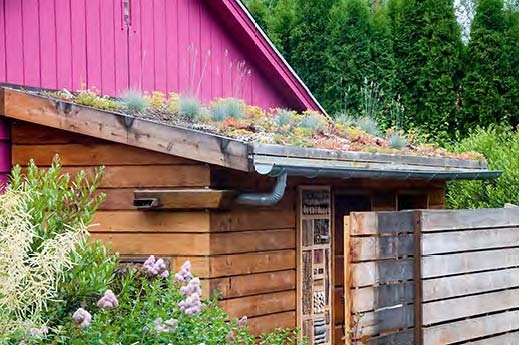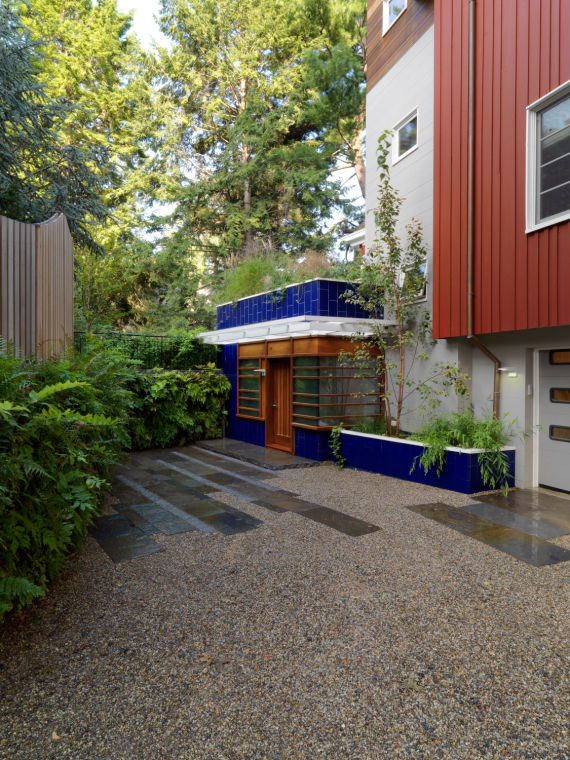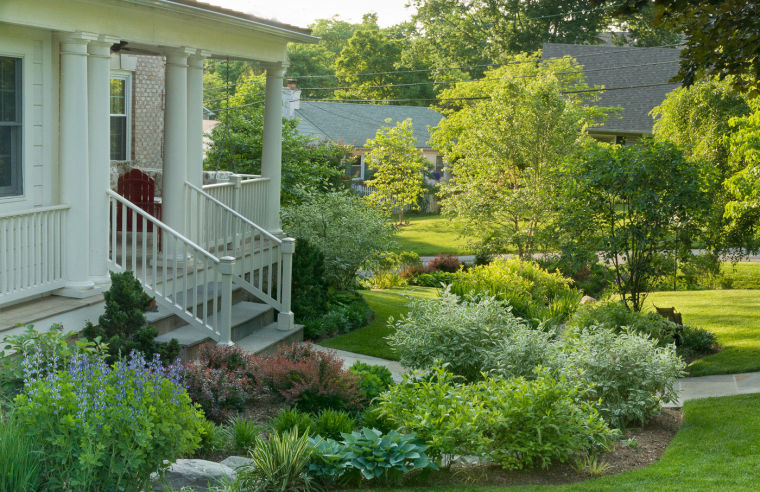‘New Homestead’ Connects Sustainability with Style
by Lynn Kirk, Public Relations Writer, Lewis Ginter Botanical Garden, reprinted with permission from the Richmond Times-Dispatch
Editors Note: Earlier this week we wrote about July Moir Messervy’s appearance at the Winter Symposium & CVNLA Short Course: Sublime + Sustainable. Here’s Messervy’s take on green design solutions and creating a “New Homestead.”

Photo by Ken Gutmaker
Designer Patricia St. John created this Asian-inspired, eco-conscious backyard on a budget, repurposing materials from the old deck and concrete patio. From ¨Landscaping Ideas That Work” by Julie Moir Messervy (Taunton Press, 2013), p. 78.
The size and sheen of today’s solar panels are not easy to hide in a landscape. How can we elegantly integrate them onto our land while still generating renewable energy?
Similarly, controlling rainwater runoff by allowing it to soak into the ground requires creating a swale or depression. How can we turn such a low point into a beautiful sustainable garden?
“Sometimes green solutions on our properties can look downright ugly,” said Julie Moir Messervy, an award-winning landscape designer, author and lecturer based in Vermont. “But these days, there are so many ways to create landscapes that combine ecological practices with attractive design.”
Messervy has written six books that explain landscape-design concepts in simple terms for homeowners. Her latest is “Landscaping Ideas that Work.”

Photo by Allan Mandell, This clever green roof design captures water to sustain the surface plantings, while it also diverts the overflow to plantings on the ground below. From ¨Landscaping Ideas That Work” by Julie Moir Messervy (Taunton Press, 2013), p. 166.
“Good design is not only affordable, approachable and attainable, it’s also sustainable,” she said.
Messervy contends that, with focus and know-how, sustainable features such as solar panels, rainwater collection systems, green roofs and beds planted with native plants can be blended into home landscapes in imaginative and aesthetically pleasing ways. On your property, sustainability and style can go hand in hand for those unwilling to sacrifice one for the other.
According to Messervy, a “new homestead” accomplishes both: The house and its adjoining land use time-honored, earth-friendly practices that harmonize with today’s green technologies and materials — all arranged using principles of good design.
“We strive for beauty and meaning as we seek to link good landscape design with sustainable outdoor living,” she said.

Photo by Susan Teare JMMDS designed this verdant green-wall courtyard and permeable peastone driveway for an urban residence on a tight lot. From a¬¢,aᬮaa¨Landscaping Ideas That Work” by Julie Moir Messervy (Taunton Press, 2013), p. 88.
To create your own “new homestead,” Messervy recommends beginning with four basic concepts.
Come from the earth. “Start by respecting the earth, by learning from it and responding to it,” Messervy said. “Past generations lived on the land in appropriate ways, providing sustenance not only for themselves and their families, but also for the land.” She contends that new sustainable methods and practices can be grafted onto old ideas of living lightly on the land.
Opt for double duty. “Do two things at once and instantly they become more integrated into your life and property,” Messervy said. For example, a brick retaining wall can be replaced by a sustainable green wall that performs the same function while doubling as an eye-pleasing vertical garden for native plants.

Photo by Melissa Clark Landscape designer Melissa Clark transformed a perpetually soggy front yard into this lush rain garden. From ¨Landscaping Ideas That Work” by Julie Moir Messervy (Taunton Press, 2013), p. 141.
Start with an organizing strategy. “Don’t plunk a vegetable garden, orchard or solar panel just anywhere in your yard,” Messervy said. Instead, see every feature as part of a larger concept — a “big idea” that helps to unify disparate parts of your property. Do you want to create a “grandchild paradise” for instance, or a wildlife sanctuary, or an edible landscape? Determining what your property might become helps you get there.
Demystify landscape design. Education is a valuable tool with DIY landscape projects. Use resources geared to homeowners, such as books, blogs and websites. Especially helpful are apps that enable homeowners to mock up their property and get help designing it. Armed with these tools, “What once might have felt scary can now become play,” Messervy said. “Homeowners can more confidently design their own homestead with a focus on sustainability with style.”
Editor’s Note: This article first published in the Richmond Times-Dispatch, in February 2014.